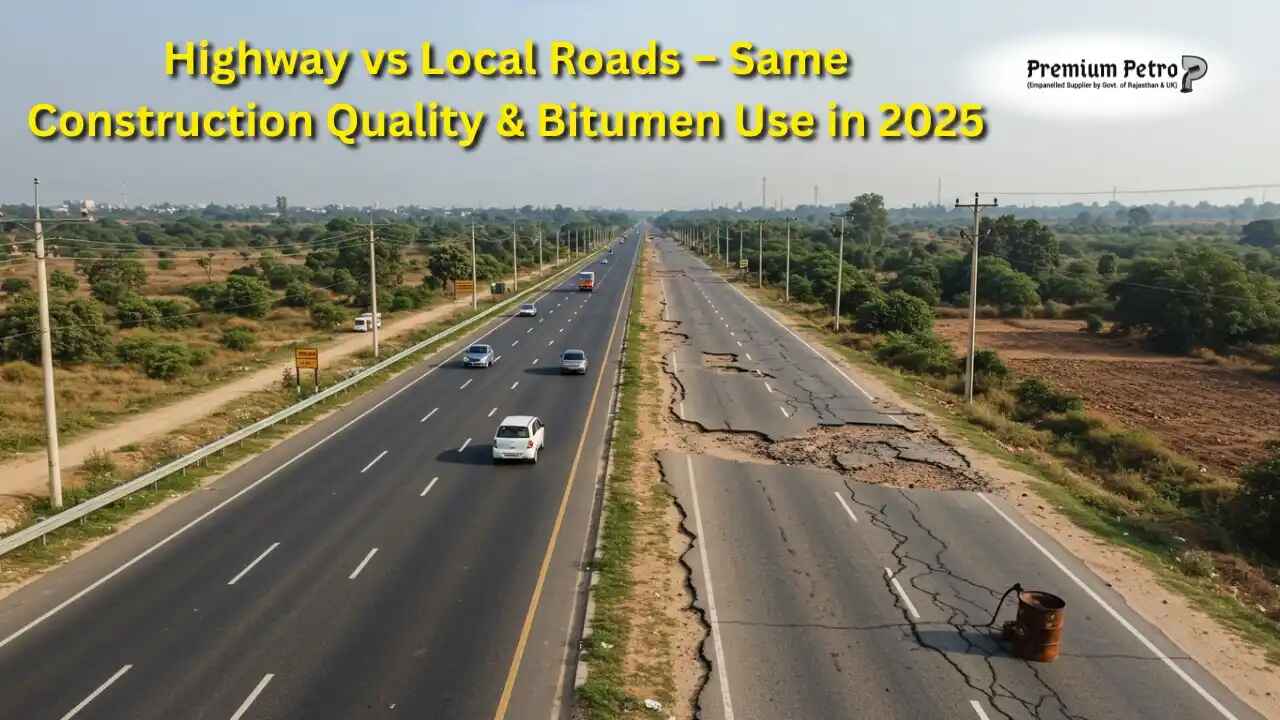2025-07-05 | Pankaj Jangid
HIGHWAY VS. LOCAL ROADS: WHY QUALITY SHOULD BE THE SAME EVERYWHERE?

Introduction
Highway vs Local Roads Same Construction Quality & Bitumen Use in 2025
A Pothole, A Delay & A Realization
Last month, Ravi, a bitumen dealer from Jaipur, was heading to a nearby village to meet a road contractor. He cruised smoothly on the six-lane highway, enjoying the speed and comfort. But as soon as he exited towards the local road, things changed fast. A sudden pothole jerked his car. Within minutes, the road turned into a patchy trail of uneven surfaces. It made him wonder - if highways can offer world-class quality, why can’t local roads match up too?
This question is not just about comfort. It’s about safety, economy, and long-term planning. Why should there be a double standard in road quality between highways and local roads when both are equally important for connectivity?
Let’s dive deeper into why construction quality should be uniform, no matter the scale.
Why Do We Treat Highways Differently?
Highways often steal the spotlight in infrastructure planning. They carry heavy traffic, connect major cities, and are funded generously. So, they’re expected to be wider, smoother, and more durable. According to the Ministry of Road Transport & Highways, India constructed over 12,349 km of national highways in 2025-26, with billions allocated for their maintenance and expansion.
But here’s the catch - more than 65% of road traffic begins or ends on local roads. These roads are essential for daily commutes, transporting goods to nearby towns, or connecting villages to markets. Yet, many are built using outdated materials or suffer from poor maintenance.
What's the Real Difference in Construction?
At the core of road durability lies material selection and execution. Highways are usually constructed using premium-grade VG-30 This bitumen is primarily used for the construction of extra-heavy bitumen pavements that have to bear significant traffic loads. or VG40 bitumen is used in areas in which high pressure comes from heavy traffic loads, such as intersections, near tolls booths, and truck parking lots., modified emulsions, and strict compliance standards. They’re designed to last decades.
Local roads, on the other hand, are often laid with lower-quality binders, uneven base preparation, and limited quality checks. Many times, they are victims of budget constraints or rushed deadlines.
But here’s a simple truth - whether it’s a national highway or a village link road, the technology is available to build both with equal quality.
The Hidden Costs of Poor Local Road Quality
When local roads are compromised:
- Repairs become frequent, increasing costs
- Vehicles suffer more damage
- Farmers lose access to markets during monsoon
- Students walk longer or miss schools altogether
According to the World Bank, poor rural roads can reduce agricultural income by 15-30% due to market inaccessibility. That’s not a small number for India’s rural economy.
So while it might seem cheaper to use less durable materials on local roads, the long-term economic impact is far greater.
Bonus Tips:
Which is Better VG-30 vs VG-40 Bitumen for Indian Roads?
India’s Road Infrastructure 2025 | Role of Bitumen and Emulsion
Quality Should Not Be Selective - It Should Be Standard
Whether it’s a four-lane expressway or a one-lane road connecting two hamlets, every road user deserves safety. Poor construction doesn't only reduce lifespan - it increases accident risks. The National Crime Records Bureau (NCRB) reports that over 12% of road accidents in India occur due to bad roads.
This calls for one thing: uniform standards. It’s time we stop thinking “local roads don't need premium quality.” They absolutely do - for health, for trade, for education, and for emergency services.
How Modern Materials Can Change the Game
Advanced materials like polymer-modified bitumen (PMB), CRMB, and cationic emulsions are no longer restricted to mega projects. They’re now accessible and scalable. Local contractors and PWDs can adopt the same materials and methods used in highway construction - just in smaller quantities.
One such supplier, Premium Petro, helps road contractors across India access quality-grade VG-30 and VG-40 bitumen & emulsion, and CRMB - ensuring that even remote road projects are not compromised by poor inputs.
They supply to both large infrastructure firms and small contractors, making sure that construction quality doesn’t depend on location or scale, but on intention and execution.
Think Long-Term, Not Low-Budget
It’s tempting to cut costs in local projects. But if a road fails within 6 months and needs repairs every year, it eventually costs more than doing it right the first time.
When we invest in strong foundations and trusted materials:
- Roads last longer (8–10 years vs. 2–3 years)
- Less disruption to traffic
- More savings in public funds
- Greater trust in government projects
Local roads are not temporary fixes. They are lifelines. They deserve to be built with the same mindset as highways.
Let’s Build India, Not Just Highways
If India is truly aiming for Viksit Bharat 2047, then every stretch of road - be it on the outskirts of Jaipur or the lanes of Varanasi - must be built with lasting quality.
The change doesn’t need massive budgets. It needs better planning, better materials, and better intent.
And if bitumen suppliers, contractors, and local agencies work together - just like on large-scale highway projects - the impact on regional growth could be enormous.
Opinion
A road is more than asphalt and stone. It's the path to opportunity, safety, and progress. Whether it leads to a metro city or a small school in a village, its quality should never depend on its width.
